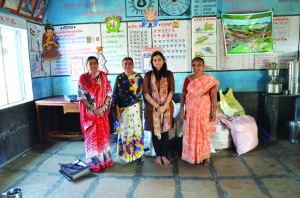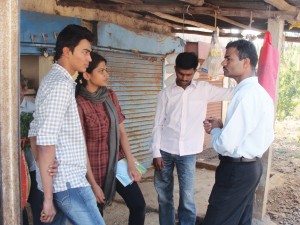 Bored of life in the city and the same old careers it offers? OPT to work in the rural sector then. Apart from being a challenge, this is one of the most satisfying choices you can make
Bored of life in the city and the same old careers it offers? OPT to work in the rural sector then. Apart from being a challenge, this is one of the most satisfying choices you can make
“The possibilities of suburbia are exhausted, and your capacity to dream has reached a dead end,” said sociologist and writer Donna Gaines in a book. She was talking of the decadence and decay of urban and suburban life, but read between the lines, was she encouraging us to look towards the rural countryside? Perhaps I am reading too much into her words, but what cannot be discounted is that the rural country is as significant to a nation’s development as is the urban.
Okay, so the countryside may not have high-end restaurants, malls and multiplexes, but the arable land out there supplies us and the rest of the country with food. Apart from that, the rich valuable natural resources available in rural India are priceless: coal, natural gas, petroleum – you name it – they are all mined for outside the cities. Why then is rural India still neglected? Why are there still villages that have no electricity, running water, schools, hospitals or even adequate transport to the nearest town or city? One could argue that since nearly 70 per cent of our staggering 1.2 billion-strong population lives in rural India, it is difficult to take care of them all. That is a valid argument, consdiering the Ministry of Rural Development under the country’s government is not sitting idly. But what we do not seem to realise is that the government alone cannot develop the country; our nation is too massive to be handled single-handedly. We, as responsible citizens, could lend our helping hands and effect change.
The Worker
With this notion in mind, in 2010 Pooja Lapasia, a journalism graduate then only 22-years-old, ventured into rural India. Pooja had been inclined towards the rural sector for a while and wanted an enriching experience of life away from the city. Taking up the ICICI Fellows’ Management & Leadership in Rural Development Program which places young people in rural India, she committed two years of her life to a village called Rukka, about 20 km away from Ranchi, Jharkhand. Armed with only her degree and her strong communication skills, she began work in the Public Health department. Pooja says she did “anything and everything” she could, right from working with anaemia-stricken teenage girls, revamping the nursing school in the village, helping out with agriculture to diversify cultivation and animal rearing and thus increase income, to helping rural youth with BPO jobs and working for the rights of the rural residents to secure work through the Mahatma Gandhi National Rural Employment Guarantee Act (MNREGA).
Although working to uplift the people in rural India is a satisfying experience, it can take quite some time to realise and feel that a difference is being made. For Pooja it took around four months to be accustomed to her rustic environment and nearly six months to settle in her job. For a fresher who had no previous, substantial knowledge of the countryside, Pooja gradually developed a deeper insight into her work. But it took a year of tireless efforts for her to start seeing the impact she had made on the village. She was soon given the flexibility to work in other departments which helped her gain a broader perspective of what it takes to develop the rural sector in India.
The Student
Now realising that young, helping hands are what rural India needs, higher education institutes and certain degrees have put in place courses and internships in the rural sector. The Bachelor of Management Studies (BMS) degree offered by Mumbai University has a compulsory paper on Rural Marketing in the third year. Although the premise of this paper is ‘the urban market is saturated therefore inroads must be made into the rural market’, it does manage to familiarise students with the nature and status of the rural sector. And growth in any sector translates to increased employment opportunities in that particular sector. Says Aakriti Sharma, a BMS graduate and a current MBA Marketing student, “Today a lot hiring in business schools happen for job profiles in the rural market. Small, medium and big-sized companies are coming up with rural market-centric initiatives, even those like Amul, Hindustan Unilever Limited and ITC.” This, she says, is beneficial to both the company and the rural sector. In the process of fulfilling a need or want of the rural demographic, companies gain loyal customers.
NorthPoint Centre of Learning, a postgraduate management institute, makes it mandatory for its students to complete a two-week internship in rural India. In partnership with Rural Relations, a consumer relations organisation for the rural sector, students spend a week in Satara and another in Sangli, both in the rural heart of Maharashtra, to observe first-hand the life and marketing opportunities there. Students typically start the internship with the preconceived perception that villages are like those shown in Indian films – backward, cramped and far removed from urban India. But when they arrive, they receive quite a shock. “The villages are quite developed. The panchayat office looks like a corporate office with cubicles and other facilities,” says Nandita Roy, a former student of NorthPoint. “The Sarpanch looks nothing like the turbaned old man we are used to seeing in films.” Medical and engineering schools are also aplenty, as well as government hospitals that provide free and cheap medical facilities to villagers.
“There are many Marathi-medium schools in Satara and Sangli, and when I interacted with the teachers, they would admit with pride that some of their students have gone abroad for higher education. They too have dreams and aspirations and that was an eye-opener,” says Nandita.
This kind of development, however, is not uniform. Even remoter regions, like Rukka, where Pooja worked, the government is still making inroads. Diksha, a programme of the government’s Ministry of Rural Development, aims to train villagers themselves to help them take advantage of the various schemes offered by the Ministry and empower their community. Volunteers from the rural sector are accepted under the Bharat Nirman Volunteers programme and are trained in governance, welfare and development affairs.
Is It Worth It?
Rural India is nothing like its urban counterpart. There are no shiny buses or trains and not many pukka roads. Comforts are few and there is no running water 24×7. Travelling is also a pain unless you own a vehicle. Says Pooja, “In Jharkhand, which is Naxal affected, every other day [I] had to face a bandh. Public transport is negligible and private buses and autos are overcrowded and stuffed. An auto in which eight people can travel safely and comfortably is packed with fifteen people, a bus operator has different ticket prices for one who wants to sit, one who stands and one who travels on top of the bus.” But in the same breath, she adds, “Many a times people gave me ride in their bikes, tractors, trucks when I failed to get transport due to a bandh.”
About the people she dealt with, Pooja has nothing but praise for the rural residents. “I have had innumerable impromptu delicious meals served to me by total strangers while on field,” she says. Neha Prabhu, another NorthPoint graduate agrees. “People invite you to their houses for meals whether you are friend or foe,” she says. “One fruit-seller gave away 15 bananas to me for free! I have never experienced such generosity in any city.”
But what about their attitude towards city folk? Pooja says eyebrows were raised at her when she did not wear a dupatta with the rest of her outfit, “but [people] also invariably followed the ‘ladies first’ rule in public places”. The students from NorthPoint also had apprehensions about approaching villagers in trousers and jeans, but they needn’t have worried. No one had any grouse with their choice of clothes and interacted freely with them. “Even the women were friendly and didn’t bother with our western wear,” says Neha. “People were curious about where we were from,” says Nandita, “but they were helpful.”
Would they go back to the rustic environment of the countryside? Definitely. Pooja says the rural surroundings grew on her and she now misses it as she is back home in Mumbai. “Though my day would start early and end late, the pace of work was saner, the job more satisfying, the people warmer and the weather cooler,” she explains. “I wanted to go back to Satara and Sangli and live there, perhaps start an advertising agency,” says Neha. “I loved it there.”
Is working in rural India worth it then? We leave that to you.
Links to Rural India
- The ICICI Fellowship on Facebook:
http://www.facebook.com/ICICIFellows - The SBI fellowship for working in rural India: http://www.youthforindia.org/index.php
- The Prime Minister’s fellowship for working in rural India: http://pmrdfs.tiss.edu/
- NorthPoint Centre of Learning:
http://northpointindia.com - Rural Relations:
http://www.ruralrelations.com/ - Diksha, Ministry of Rural Development:
http://ruraldiksha.nic.in/
Volume 2 Issue 4



























